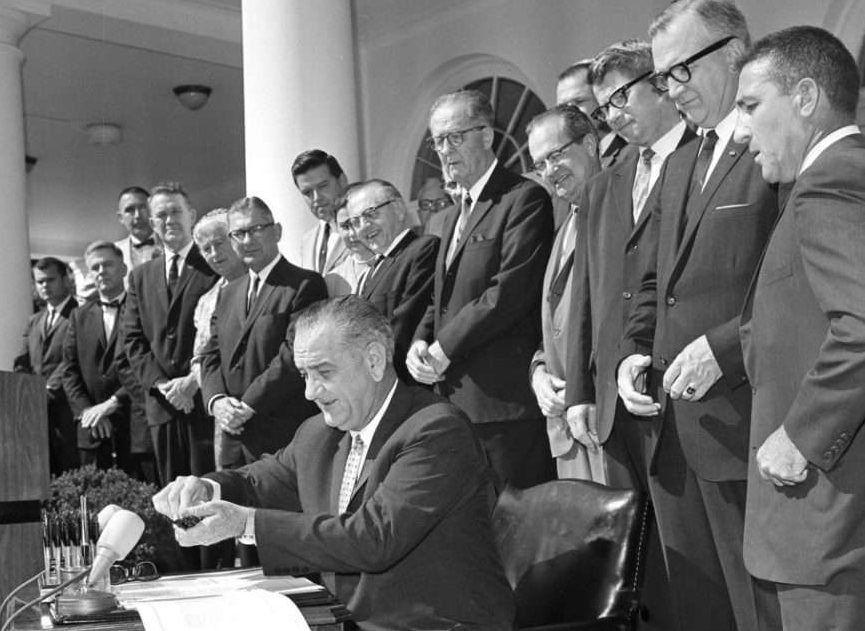
 On September 3, 1964, President Lyndon Baines Johnson signed the National Wilderness Act into law and with one stroke of his pen, protected more than 9 million acres of undeveloped federal lands.
On September 3, 1964, President Lyndon Baines Johnson signed the National Wilderness Act into law and with one stroke of his pen, protected more than 9 million acres of undeveloped federal lands.
In a photograph taken that day, one can spot Stewart Udall, Johnson’s Secretary of the Interior, with a copy of In Wildness is the Preservation of the World, the folio of Eliot Porter’s photographs (with text by Henry David Thoreu) published by the Sierra Club in 1962. With the publication of Porter’s photographs, “conservation ceased to be boring,” as one reviewer commented.
That same year, Harold Hochschild, founder of the Adirondack Museum (now Adirondack Experience) and later Chairman of New York Governor Nelson Rockefeller’s Temporary Study Commission on the Future of the Adirondack Park, commissioned Porter to photograph this region, the results of which were published in 1966 s a companion volume, Forever Wild: The Adirondacks.
Of course, the connections between the sixty-year-old Wilderness Act and the preservation of New York’s Adirondack wilderness are far less tenuous than that. Among those present at the bill signing ceremony was Alice Zahniser, widow of Howard Zahniser, universally regarded as the father of the Wilderness law.
Zahniser freely admitted that New York State provided a model for a national wilderness-preservation movement and acknowledged that he himself was inspired by the state constitutional amendment that declared the Adirondack Forest Preserve to be “forever wild.”
According to David Gibson, co-founder of the group Adirondack Wild: Friends of the Forest Preserve, Zahniser was introduced to New York’s “forever wild” clause by Adirondack wilderness champion Paul Schaefer.
Both Schaefer and Zahniser built rustic camps in Bakers Mills, in the town of Johnsburg, Warren County, and together hiked and explored the Siamese Ponds Wilderness, the High Peaks and other, more remote sections of the Adirondacks.
In fact, Zahniser drafted parts of the National Wilderness Act at his Bakers Mills cabin. On October 11, Adirondack Wild celebrated the 60th anniversary of the National Wilderness Act at its annual meeting at the Tannery Pond in North Creek, not far from Zahniser’s camp.
130 years after the constitutional amendment forbidding the destruction of the Adirondack Forest Preserve was approved and 60 years after the Wilderness Act was signed into law, there are more reasons than ever to celebrate them.
By 2050, according to the World Bank, nearly 7 of every 10 persons alive will live in cities. In the absence of wilderness areas, whether they be in the Adirondack Park, on federal lands, or elsewhere, those cities would be all but inhabitable.
According to SUNY ESF, 15% of the annual emissions of carbon from fossil fuels are already offset by American forest lands. They are natural carbon sinks, inhaling and sequestering the heat-trapping carbon that contributes to climate change while mitigating air pollution, depleted water tables and flooding – the impacts of climate change.
The line, “In Wildness is the Preservation of the World,” comes from Henry David Thoreau’s essay, “Walking.” If by “wildness” Thoreau meant “wilderness,” he was closer to the mark than perhaps even he could have imagined.
A version of this essay first appeared in the Lake George Mirror, America’s oldest resort paper, covering Lake George and its surrounding environs. You can subscribe to the Mirror HERE.
Photo: President Lyndon Johnson at the signing of the Wilderness Act of 1964 in the White House Rose Garden; also pictured are Interior Secretary Stewart Udall, Senator Frank Church, Mardy Murie, Alice Zahniser, and Representative Wayne Aspinall, among others



Recent Comments